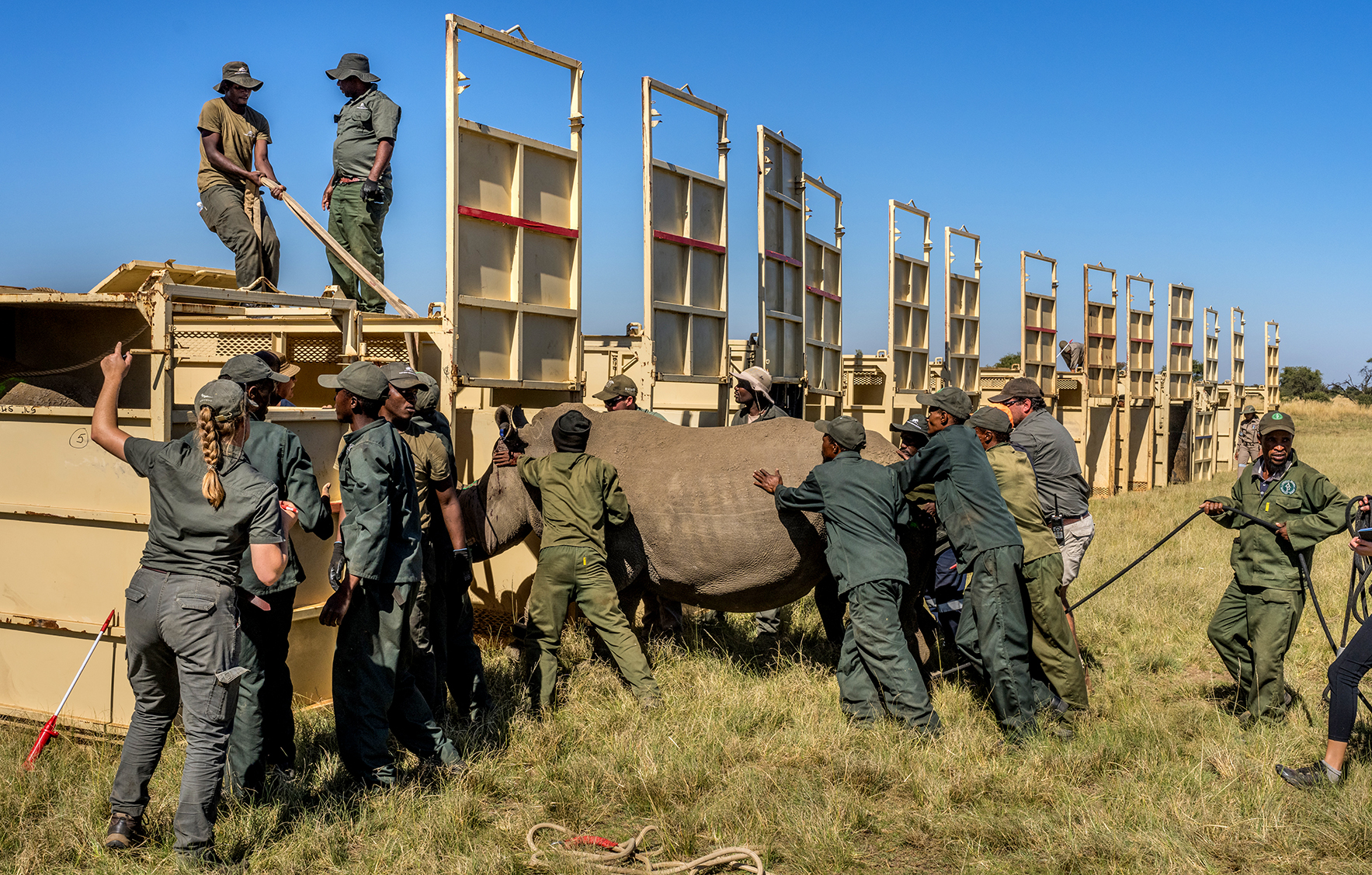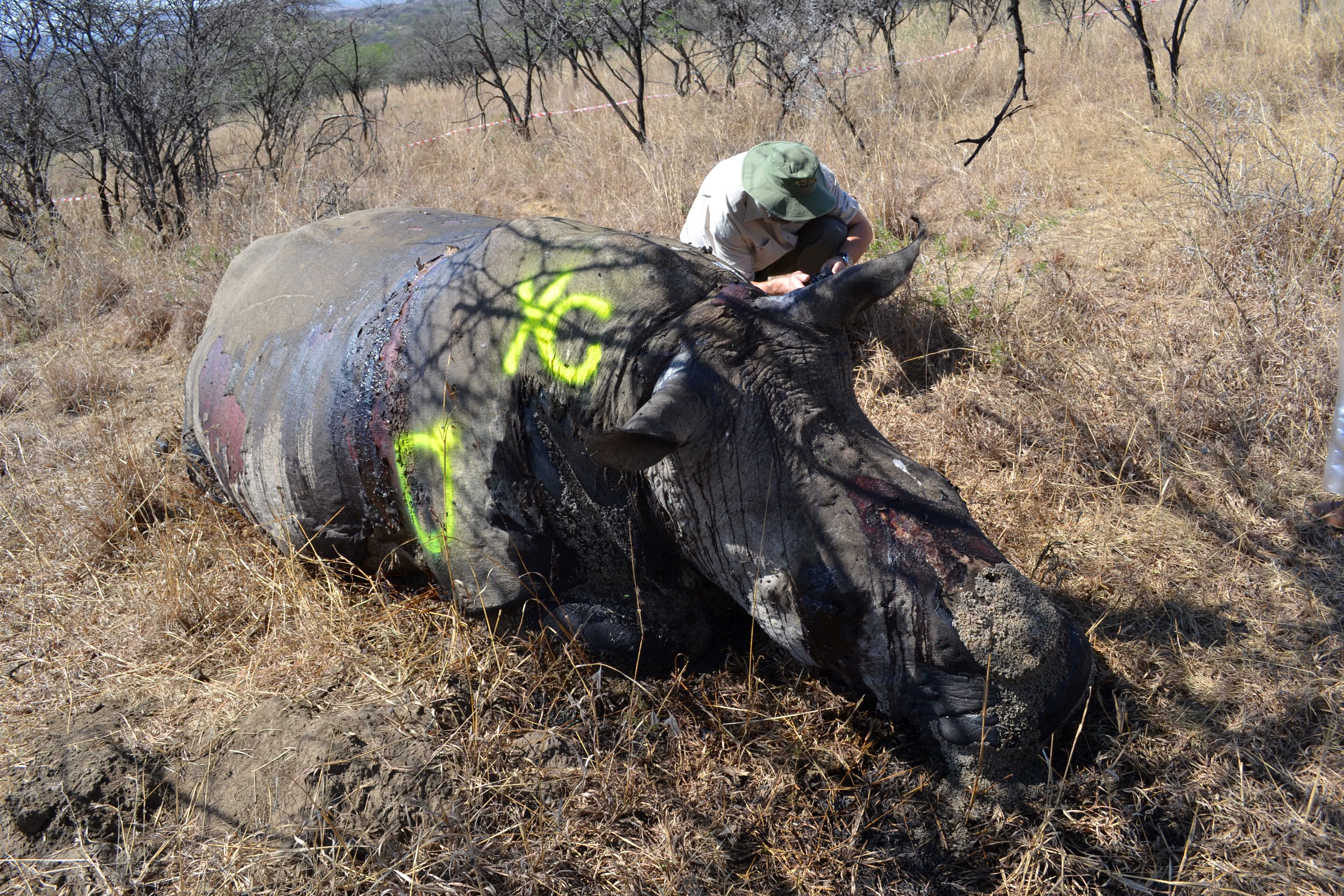REWILDING MISSION
Truckloads of hope arrive in KZN as 40 rhinos are dropped off at Munywana conservancy

A convoy of trucks carrying 40 ‘semi-wild’ rhinos has rolled into KwaZulu-Natal, delivering a welcome ray of hope to a province under brutal siege by horn poachers.
Forty rhinos, formerly part of the world’s largest privately owned rhino population, are among nearly 2,000 southern white rhinos bought last year by the African Parks group as part of an ambitious plan to rescue and then “rewild” the animals in game reserves across the continent.
The new home for this first batch of animals to be translocated is the 30,000-hectare Munywana Conservancy in northern KwaZulu-Natal, a Big Five reserve owned collectively by local communities and private landowners that includes the Makhasa Community Trust, the Mnqobokazi Community Trust, &Beyond Phinda and Zuka private game reserves
The rhinos were part of a massive private herd that multiplied over decades at a game ranch in North West owned by the entrepreneur John Hume, who planned to harvest and sell their horns legally to buyers in the Far East.
However, with no indication that the 1974 international ban on the trade in rhino horns would be lifted any time soon, Hume announced last year that he had run out of funds to keep his project going and put them all up for sale.

Game capture staff use ropes and muscle power to coax a rhino to its transport crate. (Photo:© Wiki West from WeWild)

Some of the first 40 rhinos are loaded into crates for translocation to Munywana Conservancy. (Photo: Marcus Westberg)

A convoy of game capture trucks loaded with 40 rhinos arrive at the Munywana Conservancy. (Photo: Marcus Westberg)
After the auction flopped, they were later purchased for an undisclosed sum by African Parks. The Johannesburg-based non-profit conservation organisation has long-term agreements to manage and rehabilitate 22 protected areas in 12 African countries.
Significantly, the rescued rhinos are descended from parent animals purchased at auctions over several decades in KwaZulu-Natal from the provincial nature conservation agency, Ezemvelo KZN Wildlife.
Before the massive surge in rhino poaching in South Africa that began in around 2008, Ezemvelo considered that it had too many rhinos in some of its reserves and put up scores of surplus animals for sale every year.
Relentless poaching
That’s all changed, however. Ezemvelo’s flagship, Hluhluwe-iMfolozi Game Reserve, is now under relentless attack by gangs of armed poachers. Last year, poaching of KZN’s rhino population reached its worst levels yet, with the province accounting for 65% of all rhinos killed nationwide in 2023.
In desperation, Ezemvelo began a major operation last month to reduce poaching by immobilising and dehorning rhinos in Hluhluwe-iMfolozi and other Zululand reserves to.
A rhino, with a tracking device fitted to its foot, begins to explore its new home. (Photo Marcus Westberg)
Though Munywana is barely 40km from the killing fields of Hluhluwe-iMfolozi, African Parks is confident that the first new home for Hume’s rhinos is a more secure refuge.
“The crux of the solution, and the ultimate success for rewilding these 2,000 rhinos, lies in the existence of safe, well-protected and effectively managed areas across Africa, of which the Munywana Conservancy is an excellent example,” said Peter Fearnhead, the CEO of African Parks.
The Munywana Conservancy dates back to 2007 and includes 9,085 hectares of land returned to its ancestral owners, the Makhasa and Mnqobokazi communities, as part of the national land restitution process.
Both communities have kept much of this land under conservation and dropped fences with neighbouring properties to establish the 29,866-hectare Munywana reserve.
Thokozani Mlambo, the chairperson of the Makhasa Trust — one of the four primary shareholders of the Munywana Conservancy — was among a group of local leaders who gathered at the reserve on 9 May to witness the arrival of the first rhino convoy.
“We are extremely pleased to receive these rhinos from African Parks to supplement the current population of white rhinos at our community conservancy,” he said.
“We see this as recognition of the important role that community-owned land plays in conservation, and we are proud to be collaborating in such a significant partnership to rewild rhinos across our continent.”
Barbara Creecy, the minister of forestry, fisheries and the environment, welcomed the rewilding drive’s first part.
Read more in Daily Maverick: Two out of three SA white rhinos now in private hands while poachers decimate KZN herds
“I am especially pleased to see that the very first translocation of some of the 2,000 white rhinos is going to this important landscape within South Africa, which is a flagship partnership in which communities are making a significant contribution to the conservation of our natural heritage,” she said.
“On behalf of the government of South Africa, we were very supportive of African Parks’ plan to purchase and rewild these rhinos and remain a key partner in providing technical and scientific advice and the support needed to carry out this conservation solution in South Africa and on the African continent.”

Thokozani Mlambo, chairperson of the Makhasa Trust, watches the unloading of the 40 new arrivals. (Photo: Marcus Westberg)
The new arrivals will be closely monitored as they adjust to their new environment. Previously, the Hume herds were kept in large “camps” in a relatively dry and desolate landscape in North West, where they were fed with supplemental feed during winter.
The Munywana Conservancy said it would implement “intensive security measures” to ensure the safety of the 40 rhinos, which will all be dehorned regularly to discourage poaching.
The translocation was carried out by African Parks, &Beyond Phinda, Conservation Solutions and WeWild Africa with the financial support for the move provided by the Aspinall Foundation and the Wildlife Emergency Fund.
Read more in Daily Maverick: Rewilding Africa the tough way — lessons from Majete in Malawi
“We recognise the magnitude and logistical feat of moving 2,000 rhinos. This is just the beginning of a long-term partnership with African Parks where we can play our part in making a tangible contribution to the future of the southern white rhino in Africa,” said Damian Aspinall, the chairperson of WeWild Africa.

A wildlife manager collects evidence from the carcass of a dehorned rhino in Ezemvelo’s Weenen Nature Reserve. (Photo: Ezemvelo KZN Wildlife)
Fearnhead said the “Rhino Rewild” operation was “one of our most ambitious undertakings to date, where together with a multitude of governmental, conservation and community organisations, and key funders, we have the rare opportunity to help derisk a species, and in the process to help secure some of the most critical conservation areas not just in Africa, but in the world.”
The initial funders of Rhino Rewild include the Rob Walton Foundation, the Pershing Square Foundation, WeWild Africa, the Aspinall Foundation and the Wildlife Emergency Fund. DM




















Safeguarding rhinos costs huge amounts of money. National parks do not have this sort of disposable cash. Only the sale of rhino horn can generate enough revenue to pay for the keep of rhinos. When will Creasy and her cohorts admit this truth?
Legalisation of international rhino horn trade is not up to Creecy. CITES is the international organisation which bans trade in rhino horn. Anyway, at his point I wonder if legalising horn trade would actually stop the slaughter. It is so expensive, and there are so few rhinos left, I think the poaching would just carry on. And there is evidence that the Chinese folk who buy this stuff would be willing to pay a premium for wild rhino rather than farmed rhino.
If Creecy were to lobby for horn sales, it would have an effect on CITES, we are after all the custodians of the biggest population of rhinos. Legalizing horn sales would reduce the price paid for horn, which may not stop poaching, but would make it less attractive. Some horn would come from wild rhinos, it would be impossible to know which was farmed. I doubt your assertion that “the Chinese folk” would prefer wild horn.
It is not my assertion about the Chinese folk who buy Rhino horn. It is from a study by The People’s Trust for Endangered Species and the University of Copenhagen. They interviewed actual Chinese people who buy rhino horn. The DM does not permit links in comments, but you can google it. In fact going back to about 2016, Creecy’s predecessor did explore the idea of a legal rhino horn trade, but really in the end there was no international support for this.
Thanks for the reference. The study notes “(rhino horn buyers) prefer, and are willing, to pay more for horns from rhinos living in the wild or semi-wild environments – like private ranches where they need to find food and water themselves but receive supplemental feeding at some times of the year” This about encompases all rhino horn, whether privately owned or not. The study was done in Vietnam, and did not include “Chinese folk”. The study does not find against legalizing the horn trade. Creecy, given backbone, could defy CITES. The present regime of no horn trade has seen rhino numbers plummet, if we continue on the same road, how long before the rhino is functionally extinct?
My immediate reaction to the headline was why release the name of the conservancy to the public? Surely, the poaching syndicates will be delighted with this information resulting in the rhinos becoming obvious targets.
A good point, but I think there are good reasons for publicising this. When I first heard about the African Parks rhinos, I thought it would be unlikely that any of them would be rewilded on South African land, since SA has not really been able to protect rhinos. However, this is a very interesting choice. It is community trust land, and I am sure AP would know that the communities around the parks are on board and have a stake in the success of the project. It is one of the core principles of the AP projects around Africa that the communities must be involved and on side, through a whole variety of initiatives: schools, clinics, agricultural projects, employment in the parks etc. The problem with the state parks in SA is that they are surrounded by poor communities which have no stake at all in the parks.
Thank you for your comment. The name of the conservancy will immediately be changed to ” Poacher’s Delight”.
God eyes upon you to take care of what you’ve already started
The judgement is upon your table as your own choices we willl trace the truth